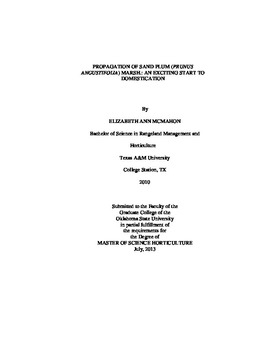| dc.description.abstract | Sand plums (Prunus angustifolia Marsh.) hold potential for further development as fruit bearing trees. Propagation information is lacking however. The objective of the first experiment was to evaluate different rootstocks for their effects on sand plum accessions, to demonstrate initial differences between sand plum accessions and to preform preliminary detection of incompatibility if possible. Experiments were performed in the field and in the greenhouse. Chip budding, t-budding and cleft grafting was used in the field and chip budding in the greenhouse experiment. Rootstocks `Lovell', `St. Julien A', and myrobalan were used at two field sites, and rootstocks `Lovell', `Nemaguard', st. julien and `Myrobalan 29 C' were used in the greenhouse experiment. Field trees were monitored for bud survival. T-budding, chip budding and cleft grafting had poor graft take in the field. Bud survival and height were measured in the greenhouse experiment. Greenhouse chip budding resulted in 66% percent overall bud survival. Accession 44 had significantly less bud survival out of all accessions and control. `Myrobalan 29 C' rootstock had significantly reduced height when only surviving buds were used. The objective of the second experiment was to determine which concentration of IBA and which season was the most appropriate to initiate high rooting success of sand plum. Three seasons (spring, summer, fall) and five IBA concentrations (0, 100, 1,000, 3,000 and 7,000 ppm) were used. Rooting percentage, root quality and presence or absence of callusing was measured. Experiment 2 cuttings in spring and summer seasons with higher (3,000 and 7,000 ppm) concentrations of IBA resulted in more rooting than cuttings with lower IBA rates. Root quality was not affected by IBA concentration or season. The objective of the third experiment was to determine the best stratification and scarification methods for sand plum seed. Seeds were stratified for 0, 30 and 60 days and scarified by the creation of a small hole in the top of the endocarp. Scarification did not produce any significant results. The 60 days stratification period had significantly highest germination. Highest germination was 60 days cold unscarified seeds at 31%. | |
